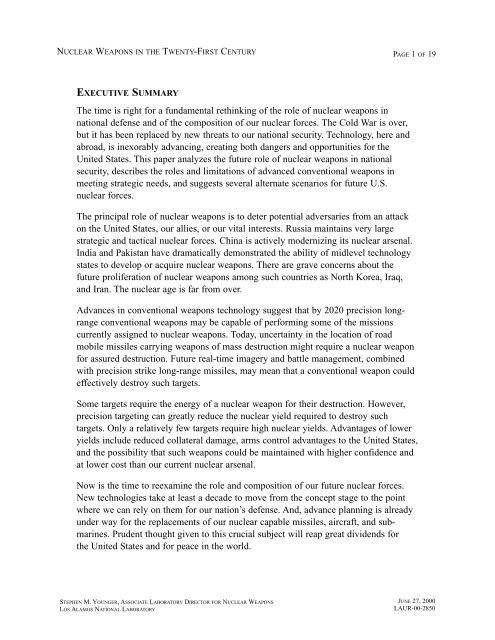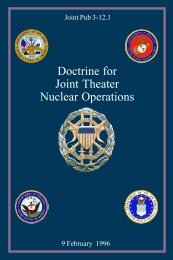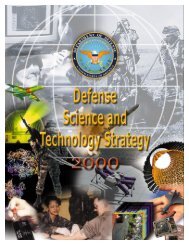Nuclear Weapons in the Twenty-First Century - Sciencemadness.org
Nuclear Weapons in the Twenty-First Century - Sciencemadness.org
Nuclear Weapons in the Twenty-First Century - Sciencemadness.org
You also want an ePaper? Increase the reach of your titles
YUMPU automatically turns print PDFs into web optimized ePapers that Google loves.
NUCLEAR WEAPONS IN THE TWENTY-FIRST CENTURY<br />
PAGE 1 OF 19<br />
EXECUTIVE SUMMARY<br />
The time is right for a fundamental reth<strong>in</strong>k<strong>in</strong>g of <strong>the</strong> role of nuclear weapons <strong>in</strong><br />
national defense and of <strong>the</strong> composition of our nuclear forces. The Cold War is over,<br />
but it has been replaced by new threats to our national security. Technology, here and<br />
abroad, is <strong>in</strong>exorably advanc<strong>in</strong>g, creat<strong>in</strong>g both dangers and opportunities for <strong>the</strong><br />
United States. This paper analyzes <strong>the</strong> future role of nuclear weapons <strong>in</strong> national<br />
security, describes <strong>the</strong> roles and limitations of advanced conventional weapons <strong>in</strong><br />
meet<strong>in</strong>g strategic needs, and suggests several alternate scenarios for future U.S.<br />
nuclear forces.<br />
The pr<strong>in</strong>cipal role of nuclear weapons is to deter potential adversaries from an attack<br />
on <strong>the</strong> United States, our allies, or our vital <strong>in</strong>terests. Russia ma<strong>in</strong>ta<strong>in</strong>s very large<br />
strategic and tactical nuclear forces. Ch<strong>in</strong>a is actively moderniz<strong>in</strong>g its nuclear arsenal.<br />
India and Pakistan have dramatically demonstrated <strong>the</strong> ability of midlevel technology<br />
states to develop or acquire nuclear weapons. There are grave concerns about <strong>the</strong><br />
future proliferation of nuclear weapons among such countries as North Korea, Iraq,<br />
and Iran. The nuclear age is far from over.<br />
Advances <strong>in</strong> conventional weapons technology suggest that by 2020 precision longrange<br />
conventional weapons may be capable of perform<strong>in</strong>g some of <strong>the</strong> missions<br />
currently assigned to nuclear weapons. Today, uncerta<strong>in</strong>ty <strong>in</strong> <strong>the</strong> location of road<br />
mobile missiles carry<strong>in</strong>g weapons of mass destruction might require a nuclear weapon<br />
for assured destruction. Future real-time imagery and battle management, comb<strong>in</strong>ed<br />
with precision strike long-range missiles, may mean that a conventional weapon could<br />
effectively destroy such targets.<br />
Some targets require <strong>the</strong> energy of a nuclear weapon for <strong>the</strong>ir destruction. However,<br />
precision target<strong>in</strong>g can greatly reduce <strong>the</strong> nuclear yield required to destroy such<br />
targets. Only a relatively few targets require high nuclear yields. Advantages of lower<br />
yields <strong>in</strong>clude reduced collateral damage, arms control advantages to <strong>the</strong> United States,<br />
and <strong>the</strong> possibility that such weapons could be ma<strong>in</strong>ta<strong>in</strong>ed with higher confidence and<br />
at lower cost than our current nuclear arsenal.<br />
Now is <strong>the</strong> time to reexam<strong>in</strong>e <strong>the</strong> role and composition of our future nuclear forces.<br />
New technologies take at least a decade to move from <strong>the</strong> concept stage to <strong>the</strong> po<strong>in</strong>t<br />
where we can rely on <strong>the</strong>m for our nation’s defense. And, advance plann<strong>in</strong>g is already<br />
under way for <strong>the</strong> replacements of our nuclear capable missiles, aircraft, and submar<strong>in</strong>es.<br />
Prudent thought given to this crucial subject will reap great dividends for<br />
<strong>the</strong> United States and for peace <strong>in</strong> <strong>the</strong> world.<br />
STEPHEN M. YOUNGER, ASSOCIATE LABORATORY DIRECTOR FOR NUCLEAR WEAPONS<br />
LOS ALAMOS NATIONAL LABORATORY<br />
JUNE 27, 2000<br />
LAUR-00-2850






